- Speaker
- Dr. Xiao-Jing Hao
- University of New South Wales, Australia
- Abstract
The uptake in future markets of the current commercialised thin film solar cell technologies, such as CdTe or Cu(In,Ga)Se2 (CIGS) is expected to be compromised by their toxicity (Cd for CdTe) or the scarcity of their constituents (In for CIGS). Therefore, research efforts have been put into earth-abundant alternatives with low/no toxicity and high-performance stability. Kesterite-based chalcogenide is such a promising stable, cost-effective and environmentally-friendly alternative providing sustainable clean energies. A decent progress has been achieved and the certified record efficiencies of 11% for pure sulfide CZTS (Cu2ZnSnS4) and 12.6% for Se-containing CZTSSe (Cu2ZnSn(S,Se)4) solar cells have been reported by UNSW and IBM, respectively. However, these efficiencies are still far below their theoretical limit as well as their chalcogenide counterpart. The current efficiency of kesterite solar cells is mainly limited by the large open circuit voltage deficit. This figure is particularly high for pure sulfide CZTS with a bandgap of 1.5ev. The Voc deficit can be as large as 650 mV compared to a typical value of less than 500 mv for CIGSe solar cells. In this work, in-depth analysis is offered of the major progress at UNSW that reduced the Voc deficit and increased the energy conversion efficiency of CZTS solar cells to beyond 10%. The future challenges for further improvement of CZTS photovoltaic device performance will be also discussed.
- About the Speaker
Dr. Xiaojing (Jeana) Hao is an inaugural UNSW Scientia Fellow, an ARC DECRA and Senior Lecturer in the UNSW School of Photovoltaic and Renewable Energy Engineering. She was previously an inaugural ARENA Research Fellow. She has been devoting herself to the research for low-cost high-efficiency solar cells for 10 years, initially using Si quantum dot solar cells, and more recently to kesterite and perovskite thin film solar cells and high efficiency tandem solar cells. Dr. Hao initiated and now leads a strong group in the above areas. Her team so far has achieved 4 certified world records in abundant, environmentally-friendly CZTS (Cu2ZnSnS4) solar cells. She was selected as UNSW “20 rising stars who will change our world” (http://www.20risingstars.unsw.edu.au). She has published 89 peer-reviewed journal papers.
- Date&Time
- 2018-01-25 10:00 AM
- Location
- Room: A403 Meeting Room




